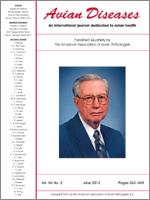A study was conducted to assess the diagnostic sensitivity and specificity of a disease surveillance method for diagnosis of highly pathogenic avian influenza (HPAI) outbreaks in household chicken flocks used by participatory disease surveillance (PDS) teams in Yogyakarta Province, Indonesia. The Government of Indonesia, in partnership with the Food and Agriculture Organization of the United Nations, has implemented a PDS method for the detection of HPAI outbreaks in poultry since 2006. The PDS method in Indonesia utilizes both a clinical case definition (CD) and the result of a commercial rapid antigen test kit Yogyakarta 55611, to diagnose HPAI outbreaks, primarily in backyard chicken flocks. The following diagnostic sensitivities and specificities were obtained relative to real-time reverse transcription-PCR as the gold standard diagnostic test: 1) 89% sensitivity (CI95: 75%–97%) and 96% specificity (CI95: 89%–99%) for the PDS CD alone; 2) 86% sensitivity (CI95: 71%–95%) and 99% specificity (CI95: 94%–100%) for the rapid antigen test alone; and 3) 84% sensitivity (CI95: 68%–94%) and 100% specificity (CI95: 96%–100%) for the PDS CD result combined with the rapid antigen test result. Based on these results, HPAI outbreaks in extensively raised household chickens can be diagnosed with sufficient sensitivity and specificity using the PDS method as implemented in Indonesia. Subject to further field evaluation, data from this study suggest that the diagnostic sensitivity of the PDS method may be improved by expanding the PDS CD to include more possible clinical presentations of HPAI and by increasing the number of rapid antigen tests to three different birds with HPAI-compatible signs of same flock.
Sensibilidad y especificidad diagnósticas de un método participativo de vigilancia para la influenza aviar altamente patógena en pollos domésticos en Indonesia.
Se realizó un estudio para evaluar la sensibilidad y especificidad diagnóstica de un método de vigilancia de enfermedades para el diagnóstico de influenza aviar altamente patógena, los brotes en pollos domésticos utilizados por los equipos participativos para la vigilancia de enfermedades en la provincia de Yogyakarta, Indonesia. El Gobierno de Indonesia, en colaboración con la Organización de las Naciones Unidas para la Alimentación y la Agricultura, ha puesto en marcha un método de equipos participativos de vigilancia para la detección de los brotes de influenza aviar altamente patógena en la avicultura desde 2006. El método participativo de vigilancia para enfermedades en Indonesia utiliza tanto una definición de caso clínico (EC) y el resultado de un estuche comercial para la detección rápida del antígeno Yogyakarta 55611, para el diagnóstico de los brotes de la influenza aviar de alta patogenicidad, sobre todo en las parvadas de aves de traspatio. Las siguientes sensibilidades y especificidades diagnósticas se determinaron con relación con el método de transcripción reversa y PCR en tiempo real como prueba diagnóstica de referencia: 1) sensibilidad de 89% con un intervalo de confianza al 95% (IC95) de 75%–97% y una especificidad del 96% (IC95: 89%–99%) para las definiciones de casos por el método participativo de vigilancia únicamente, 2) para la prueba rápida de detección de antígeno únicamente se observó una sensibilidad del 86% (IC95: 71%–95%) y una especificidad del 99% (IC95: 94%–100%), y 3) para la combinación de la definición de casos por el método participativo de vigilancia y la prueba de detección del antígeno, se observó una sensibilidad del 84% (IC95: 68%–94%) y una especificidad del 100% (IC95: 96%–100%). Con base en estos resultados, los brotes de influenza aviar de alta patogenicidad en pollos domésticos criados de forma extensiva pueden ser diagnosticados con la suf





